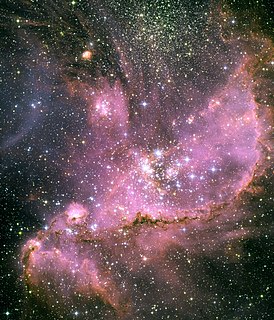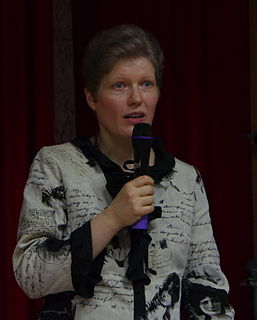
A globular cluster is a spheroidal conglomeration of stars. Globular clusters are bound together by gravity, with a higher concentration of stars towards their centers. They can contain anywhere from tens of thousands to many millions of member stars. Their name is derived from Latin globulus. Globular clusters are occasionally known simply as "globulars".

An open cluster is a type of star cluster made of up to a few thousand stars that were formed from the same giant molecular cloud and have roughly the same age. More than 1,100 open clusters have been discovered within the Milky Way galaxy, and many more are thought to exist. They are loosely bound by mutual gravitational attraction and become disrupted by close encounters with other clusters and clouds of gas as they orbit the Galactic Center. This can result in a migration to the main body of the galaxy and a loss of cluster members through internal close encounters. Open clusters generally survive for a few hundred million years, with the most massive ones surviving for a few billion years. In contrast, the more massive globular clusters of stars exert a stronger gravitational attraction on their members, and can survive for longer. Open clusters have been found only in spiral and irregular galaxies, in which active star formation is occurring.

Star clusters are large groups of stars. Two main types of star clusters can be distinguished: globular clusters are tight groups of ten thousand to millions of old stars which are gravitationally bound, while open clusters are more loosely clustered groups of stars, generally containing fewer than a few hundred members, and are often very young. Open clusters become disrupted over time by the gravitational influence of giant molecular clouds as they move through the galaxy, but cluster members will continue to move in broadly the same direction through space even though they are no longer gravitationally bound; they are then known as a stellar association, sometimes also referred to as a moving group.

The Large Magellanic Cloud (LMC), or Nubecula Major is a satellite galaxy of the Milky Way. At a distance of around 50 kiloparsecs (≈160,000 light-years), the LMC is the second- or third-closest galaxy to the Milky Way, after the Sagittarius Dwarf Spheroidal (~16 kpc) and the possible dwarf irregular galaxy known as the Canis Major Overdensity. Based on the D25 isophote at the B-band (445 nm wavelength of light), the Large Magellanic Cloud is approximately 9.86 kiloparsecs (32,200 light-years) across. It is roughly a hundredth as massive as the Milky Way and is the fourth-largest galaxy in the Local Group, after the Andromeda Galaxy (M31), the Milky Way and the Triangulum Galaxy (M33).

Rebecca Anne Wood Elson was a Canadian–American astronomer and writer.

The following outline is provided as an overview of and topical guide to astronomy:

NGC 1850 is a double cluster and a super star cluster in the Dorado constellation, located in the northwest part of the bar of the Large Magellanic Cloud, at a distance of 168 kly (51.5 kpc) from the Sun. It was discovered by Scottish astronomer James Dunlop in 1826.
Paul W. Hodge was an American astronomer whose principal area of research was the stellar populations of galaxies.

NGC 346 is a young open cluster of stars with associated nebula located in the Small Magellanic Cloud (SMC) that appears in the southern constellation of Tucana. It was discovered August 1, 1826 by Scottish astronomer James Dunlop. J. L. E. Dreyer described it as, "bright, large, very irregular figure, much brighter middle similar to double star, mottled but not resolved". On the outskirts of the cluster is the multiple star system HD 5980, one of the brightest stars in the SMC.

NGC 290 is an open cluster of stars in the southern constellation of Tucana. This cluster was discovered September 5, 1826 by Scottish astronomer James Dunlop. It lies some 200,000 light years away from the Sun in the Small Magellanic Cloud galaxy. The cluster is an estimated 30–63 million years old and is around 65 light years across.

LH 95 is a modestly sized stellar nursery in the Large Magellanic Cloud. It is related to the HII-region LHA 120-N 55, that is, a region of hydrogen ionized by the bright stars of LH 95.

Eva K. Grebel is a German astronomer. Since 2007 she has been co-director of the Astronomisches Rechen-Institut at the University of Heidelberg in Germany. Eva Grebel is an expert in the study of stellar populations and galaxy formation.
Douglas N. C. Lin is Professor of Astronomy and Astrophysics at the University of California, Santa Cruz. He was born in New York and grew up in Beijing. He earned his BSc from McGill University, his PhD from the Institute of Astronomy, Cambridge University, and performed postdoctoral research at both Harvard and Cambridge. In 1979 he took an Assistant Professorship at UCSC, and has remained there since. He is also the founding director of the Kavli Institute for Astronomy and Astrophysics at Peking University.

Amanda Elaine Bauer is an American professional astronomer and science communicator, currently based in Tucson, Arizona working as Head of Education and Public Outreach at the Large Synoptic Survey Telescope. From 2013 to 2016 she was a Research Astronomer at the Australian Astronomical Observatory (AAO). Her principal field of research concerns how galaxies form, how they create new stars, and particularly why they suddenly stop creating new stars. She is better known to the public through her efforts in outreach and education.

NGC 299 is an open cluster of stars in the main body of the Small Magellanic Cloud – a nearby dwarf galaxy. It is located in the southern constellation of Tucana, just under 200,000 light years distant from the Sun. The cluster was discovered on August 12, 1834 by English astronomer John Herschel.

Kim A. Venn is a professor of physics and astronomy at the University of Victoria, Canada, and director of the university's Astronomy Research Centre. She researches the chemo-dynamical analysis of stars in the galaxy and its nearby dwarf satellites.
Roberta M. Humphreys is an American observational stellar astrophysicist. She is Professor Emerita at the University of Minnesota. Her work has included Galactic structure, observational stellar evolution, stellar populations, and large databases. She is best known for her research on massive stars in the Milky Way and in nearby resolved galaxies.
Alyson Brooks is an American theoretical astrophysicist and professor at Rutgers University. She uses large-scale simulations to determine how galaxies form.
Thushara Pillai is an Indian astrophysicist and astronomer with a senior research scientist position at Boston University's Institute for Astrophysical Research. Her research interests have included molecular clouds, high-mass star formation, magnetic fields, astrochemistry, and the galactic center. She is known for her work that looked to understand star formation by observing magnetized interstellar clouds, and Pillai is the first astronomer to capture images of magnetic fields reorienting near areas of star formation.













